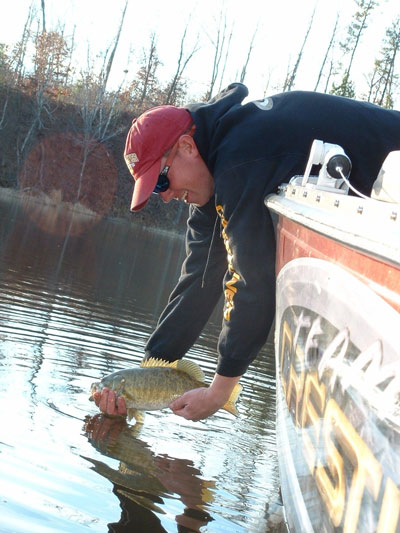|
Falling Hard for Giant Smallies
by Ron Anlauf
When someone said good things come in small packages they must have been
talking
 about
smallmouth bass. Those little bronze bundles of joy have the ability to show
you a terrific time, especially when they smash a top water lure or go
airborne for the second time. As much fun as that can be the effect can be
amplified when dealing with the largest of the species. Sticking four, five,
and even six pound plus smallmouth bass is what we’re talking about and is
unfortunately a rare occurrence for most anglers. about
smallmouth bass. Those little bronze bundles of joy have the ability to show
you a terrific time, especially when they smash a top water lure or go
airborne for the second time. As much fun as that can be the effect can be
amplified when dealing with the largest of the species. Sticking four, five,
and even six pound plus smallmouth bass is what we’re talking about and is
unfortunately a rare occurrence for most anglers.
Smallmouth in general have earned a reputation for being ghost like, and
only seem to show themselves when they feel like it. That characteristic
gives an appearance of being aloof and playing hard to get, which really
adds to their overall mystique. Throughout most of the open water season
smallies can be rather difficult to pin down, especially if you’re targeting
the larger models. While that might be the case most of the time there is a
great equalizer, and it comes during the early fall period.
Late summer and early fall is when everything comes together and when
smallmouth bass lose a good deal of their indifferent attitude and become
much more predicable. Now you can actually count on them to be where they
should be, and when they are most likely to posses an aggressive bait
chasing, grub munching, tail dancing, and much improved state of mind.
Instead of a few fish here and a few there fall smallies bunch up in
super schools, where they become particularly vulnerable once their location
is revealed. The key of course is location and really isn’t all that
difficult to put together when you take a look at the big picture. The big
picture includes a good deal of rocks, rocks that play host to thousands of
crayfish. Crayfish make-up the lion’s share of a smallie’s diet and are the
reason for all of the rock bottom attention.
Team Crestliner Member John Janousek of Nisswa, Minnesota knows the ins
and outs of late season smallies and has been keying on a small river
pattern that has produced outstanding results for quite a few years.
According to John: "The upper Mississippi isloaded with big smallmouth that
are typically spread out through most of the summer period but by early
September they start to migrate downstream and stack up in the deeper pools
above the dams.
The move seems to be triggered by dropping water temperatures and results
in mega schools of smallmouth bass filing into specific structures like
current breaks, log jams, and rocks. Current determines where they can be
expected to set up with light flows opening up the main channel and heavy
flows pinning them closer to current breaking structure like rocky points or
log jams.
It doesn’t take long to find out if there is anybody home and five
minutes or so is about all the time I’ll spend looking for active fish
before heading to the next spot. On the other hand I will go back and fish a
good looking spot again and again, especially if I think it has the "right
stuff" to produce."
Good presentations include the usual fare like tube worms, grub tails,
crankbaits and even top water lures. "During the fall period it’s the warm
sunny afternoons that are ideal for working topwater baits like Skitter Pops
and Skitter Props. With cooler water temps a penetrating sun can give a
smallie’s metabolism a boost and is what it usually takes to get things
going on top.
Log jams can hold numbers of big fish but require some special gear to
get the job done. Abrasion resistant line in the seventeen to twenty pound
range, flippin’ sticks, and Texas rigged plastics are what’s required to
keep a giant smallmouth from hanging you up when it tries to bury in heavy
cover. Productive plastic baits include tubes and 4" grub worms in crayfish
patterns.
Fish holding near deeper rocks can be quickly worked with deep diving
crankbaits likethe Rapala DT 6 and DT 10. The key is to use a bait that
dives deep enough to continually bang into the bottom. Crayfish patterns are
again the hottest fall colors and include a good dose of orange and red."
Rock running smallies can also be worked with an exposed hook and worm
rig like the Northland Tackle Rattlin’ Inner-Tube Jig and a tube lure or
grub worm. An exposed hook will get hung up occasionally but will also
result in more fish hooked. Water temperatures will determine on how
long the good action will last and will slow considerably when it drops into
the fifties, although you can still catch fish on the nicer days. In the
upper Midwest September and October produce the hottest action but may last
even into November. See you on the river. |




 about
smallmouth bass. Those little bronze bundles of joy have the ability to show
you a terrific time, especially when they smash a top water lure or go
airborne for the second time. As much fun as that can be the effect can be
amplified when dealing with the largest of the species. Sticking four, five,
and even six pound plus smallmouth bass is what we’re talking about and is
unfortunately a rare occurrence for most anglers.
about
smallmouth bass. Those little bronze bundles of joy have the ability to show
you a terrific time, especially when they smash a top water lure or go
airborne for the second time. As much fun as that can be the effect can be
amplified when dealing with the largest of the species. Sticking four, five,
and even six pound plus smallmouth bass is what we’re talking about and is
unfortunately a rare occurrence for most anglers.